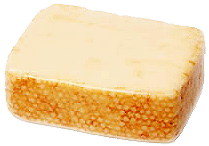|
|
|
||||||||||||||||||||||||||||||||||||
|
|
 The
name "Münster" comes from the city of Munster where the cheese was
developed by the monks, and refers to the Latin monasterium
(monastery). The
name "Münster" comes from the city of Munster where the cheese was
developed by the monks, and refers to the Latin monasterium
(monastery).A delicate to mild to pungent, hint of saltiness; semi-soft. Originally one of the monastery cheeses from the Alsace region in France. The highly prized European Muensters have red or orange rinds and a smooth, yellow interior with small holes.
Uses: Appetizers, sandwiches, snacks, dessert
|
||||||||||||||||||||||||||||||||||||
